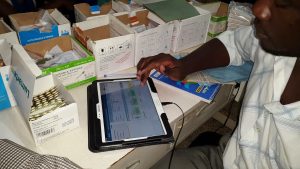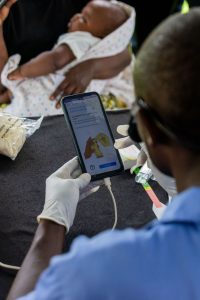Traditionally, the process of administering vaccines and keeping track of a child’s vaccination schedule involved paperwork, with parents often receiving physical forms or booklets outlining the vaccination timetable. However, with the advancement of technology, this paradigm is swiftly shifting towards a more efficient and convenient system.
In many modern healthcare facilities, the age-old practice of distributing paper forms or booklets to parents has been replaced by digital solutions. Upon the birth of a child, instead of receiving physical documents, parents now find themselves receiving timely notifications via their mobile phones. This transition to digital platforms, particularly through Short Message Service (SMS) notifications, has revolutionized the way parents engage with their child’s vaccination schedule.
The process begins immediately after the child receives their first vaccination. Rather than waiting for physical paperwork, parents now receive a prompt SMS notification confirming the administration of the vaccine. This real-time communication not only provides peace of mind to parents but also ensures that vital healthcare information is relayed promptly.
One of the most significant advantages of this digital approach is the accessibility and convenience it offers to parents. Unlike paper forms that can be misplaced or forgotten, SMS notifications are readily available on the parent’s mobile device, allowing for easy reference at any time. Furthermore, the integration of the vaccination schedule into the digital notification ensures that parents are continuously informed about upcoming vaccinations and their respective timelines.
Moreover, the transition to digital notifications enhances the efficiency of healthcare providers by reducing administrative burdens associated with paper-based systems. By automating the process of notifying parents about vaccinations, healthcare professionals can allocate more time and resources to direct patient care, thereby enhancing overall service delivery.
Additionally, digital notifications offer an opportunity for healthcare providers to improve communication and engagement with parents. Through SMS alerts, parents can receive valuable educational resources about the importance of vaccinations, potential side effects, and other relevant information. This proactive approach fosters a collaborative relationship between healthcare providers and parents, ultimately leading to better healthcare outcomes for children.
Despite the numerous benefits of digital notifications in childhood vaccination, it is essential to acknowledge and address potential challenges. For instance, ensuring that parents have access to mobile phones and reliable network coverage is crucial to the success of this system. Moreover, efforts must be made to accommodate parents who may face language barriers or technological literacy challenges.
In conclusion, the transition from paper-based forms to digital notifications represents a significant step forward in modernizing childhood vaccination practices. By leveraging technology, healthcare providers can streamline administrative processes, enhance communication with parents, and ultimately improve the delivery of pediatric healthcare services. As we continue to embrace digital innovation in healthcare, it is imperative to prioritize inclusivity and accessibility to ensure that all parents can actively participate in their child’s vaccination journey.
HISP Rwanda has been running a training program which consists on the use of the two immunization programs or vaccination programs particularly focusing on the implementation and utilization of two electronic systems: EVLMIS ((Electronic Vaccines Logistics Management Information System) and EIR (Electronic Immunization Registry). The integration of EVLMIS) and EIR) into immunization programs presents an opportunity to streamline processes, enhance data management, and improve vaccination coverage. This training program aims to equip healthcare professionals with the necessary knowledge and skills to effectively implement and utilize EVLMIS and EIR in their respective immunization programs

The first phase which consisted on vaccination program teams at the central level had the Training of trainers as the target participants but also the Expanded Program of Immunization supervisors. It also included the Hospital staff, Ministry of Health digitalization teams as well as Monitoring and Evaluation office representatives. In a period of 5 days (12-16th February 2024) at FATIMA Hotel in Musanze District of Northern province, participants were equipped with the necessary skills and knowledge to effectively implement and utilize EVLMIS and EIR in their immunization programs, thereby contributing to improved vaccine management and healthcare delivery.
The 2nd Phase of Cascaded Training brought together nurse vaccinators at health centers and health posts in a period of 4 days respectively in Muhanga (south) and Musanze (North). The 3rd phase which consisted on leadership contribution had Directors and midwives from all hospitals nationwide and health centers managers as the targeted participants. The main objectives were to engage leaders in the implementation process and orientation meetings.


Overall, the program seems comprehensive, covering different levels of stakeholders and ensuring proper training, testing, and support for the implementation of the electronic systems in immunization programs. The way forward will be about transfer developed content from testing instances to production instances, ensure smooth transition and functionality of the systems. About user Testing, there will be one-month period for users to test the systems and provide feedback. Concerning On-site Support and Supervision, they will provide support and supervision on-site after the testing period and address any issues or concerns raised by users.

vaccination card
All the modules cover different topics such as understanding the importance of EVLMIS and EIR in immunization programs. familiarizing participants with the features and functionalities of EVLMIS and EIR, developing proficiency in data entry, management, and analysis using EVLMIS and EIR. It includes to learn best practices for integrating EVLMIS and EIR into existing immunization workflows, enhancing skills in troubleshooting and resolving common issues related to EVLMIS and EIR utilization. All these with the aim with promoting collaboration and communication among healthcare professionals involved in immunization programs. END